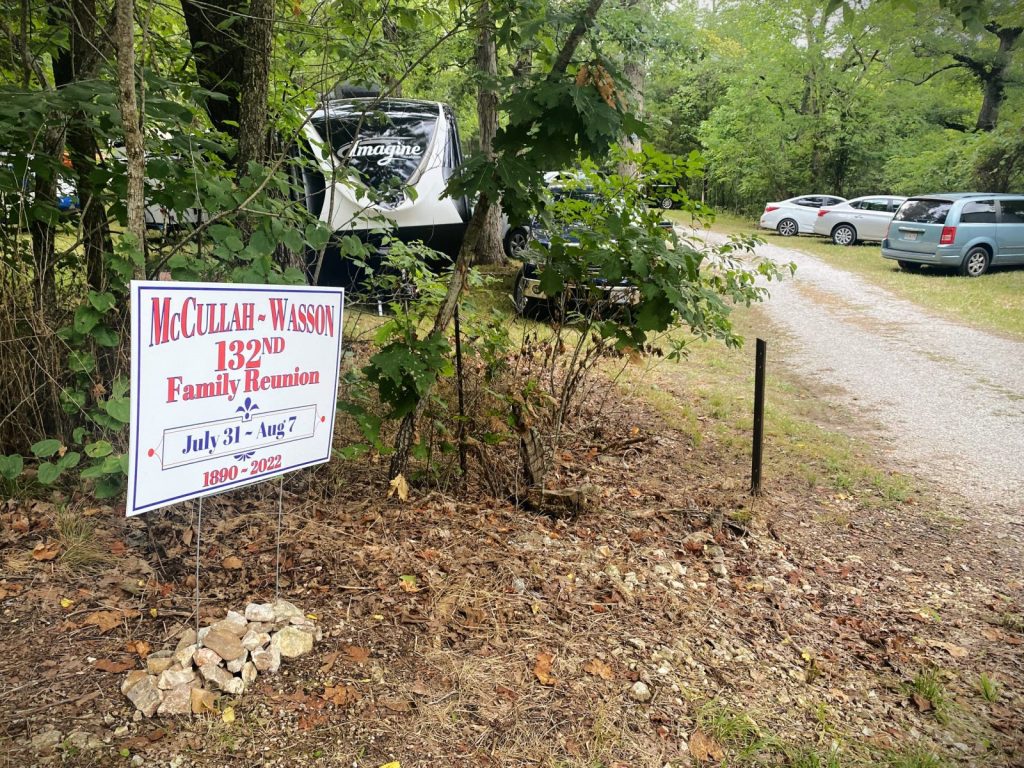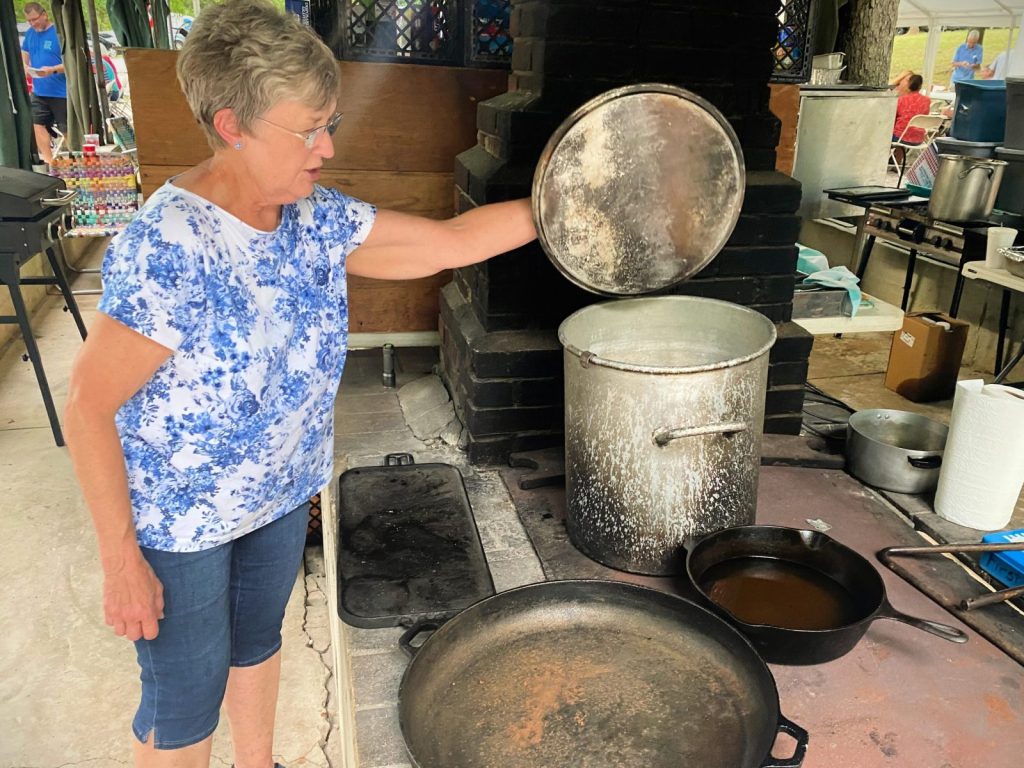This story is published in partnership with Ozarks Alive, a cultural preservation project led by Kaitlyn McConnell.
RURAL CHRISTIAN COUNTY - For generations, babies from a few months old to family members whose faces are now lined with age have gathered on the banks of a river in rural Christian County for the McCullah-Wasson Reunion.
Now in its 132nd year, the week-long gathering is said to be the longest-running family reunion west of the Mississippi River. Every August, it brings together people from right down the road and people from states away for food, fellowship and a continuation of tradition.
“A company came down out of Boston and filmed us and spent a week with us and put us on a public television program,” says Hattie Wasson Carter of a year in the 1990s. “They had researched the nation, and they couldn’t find any other reunions that were like ours. So we know we're kind of out there — kind of different.”

Some of the youngest members are brought by their families. Others are pulled by their heartstrings, and the memory of those parents long ago.
“It's all about family,” says Kirk Hawkins. “It's all about family and staying connected. We don't have kids, but we have nephews and nieces and cousins. That's what it's all about.”
The history behind the tradition
The story behind the reunions began in the mid-1800s, when John Thomas Wasson traveled to the Ozarks from Ohio by way of Arkansas. When the stagecoach he was riding on stopped near Hurley, he saw a young woman named Caroline McCullah sweeping a porch. Even though that wasn’t the reason the stage stopped, it was enough to stop him.
“He looked at her and thought, ‘That’s her. That’s the woman I’m going to marry,’” says Carter. “It’s a true story.”
While Wasson got back on the stagecoach, Carter says, he soon returned and asked McCullah to be his wife. The results of that question are seen on the banks of the Finley every summer, where hundreds of people may gather to visit and reconnect.
The reunions began in 1890, but the folks back then didn’t know they were starting a tradition. It was a surprise, one-day birthday party for Samuel Calvin McCullah, who was turning 52. The gathering was so much fun that the family decided to do it again — and again and again.

“For probably 10 years, they were moving from farm to farm. And then finally they started having it here on the riverbank,” says Carter. “They enjoyed this area because everybody could reach this area pretty easily. There were family members in the area, and it was on the river. They liked the idea of camping out.”
That property near an iconic old iron bridge is still in the family, and the gatherings have been there ever since. Nowadays, though, people may come from farther away, shown by out-of-state license plates parked nearby.
“It's just a fact of the feeling that we get down here,” says Carter, who has never missed a reunion in her 74 years. “We come down here, and you may have had a wonderful year of successes, and you want to share. Or you come down here, and you've had a pretty crappy year; you've had some illness, you've lost a loved one, you’ve lost some money. You've had some hard times. You can come down here, and you can share that with somebody, and they can sympathize with you.”
How it works
The annual event starts on Sunday, when folks begin to arrive.
A collection of campers and tents fill the grassy area near the river, and that’s where many folks stay throughout the week. Others come in for part of the time, while others who live thereabouts may simply come and go. Attendance generally increases throughout the week, with Friday being the cumulation.
Food is a key part: Two meals a day — breakfast and dinner, cooked on-site, are part of the gathering.

Chris St. George, owner of St. George’s BBQ and Catering in Springfield, leads that meal prep these days. But it’s more than a job: He’s also part of the family and grew up attending the reunions.
“I mean, this is awesome,” he says. “Hanging out, camping out — when you're growing up as a kid, you’ve got all these kids to play with. You’ve got the river; you’ve got the cave across the way. You kind of grow up with it — and then you’re hooked. You either hate it or you love it, and most people love it.”
St. George says generally he plans for around 125 people a night, with swelling numbers towards the end of the week, but has cooked for crowds upward of 300 or 400 people — facts that translate into significant effort, but also significant expense.
While there is no set fee to attend the reunion, the food is a reason that funds are needed. Donations are accepted from families to help offset the cost, but they also have fundraisers, such as an annual craft auction.
Despite that expense — and commitment, both from planners and attendees — the event has never been canceled.
“During the Second World War, it wasn't attended really heavily, because the men were all gone,” says Carter. “But the women carried it on and the children carried it on there for about three or four years.”
Even during the COVID-19 pandemic, a few people gathered to keep it going.
Just as they pitch in to help when needed.
“We just love getting together,” says 12-year-old Grace Mummert, who washes dishes after dinner alongside her relative, Max Brown. The duo agrees that the reunion, despite their younger ages, is something worthwhile.
“Family — some of us only get to see each other once a year, which is here,” says Mummert, who lives in Kansas City. “It's just fun to get to see everybody.”
More than just a week

The young and young-at-heart are bonded by similar experiences: Swimming at the river, exploring the nearby cave and eating meals cooked in the pavilion.
“This was such a big part of my growing up,” says Hawkins, who was born in 1950 and, other than some time away for military service, has attended every year.
He reminisces of days long gone but still alive in his memory: Ones filled with boyhood wanderings that began early and seemed to never end, including exploring that cave where he once carved his initials.
“We didn’t have a watch, we didn’t know what time it was — supper would be over,” says Hawkins. “We’d been gone the whole day.
“We’d kind of wander around, and then we’d have to wait until like 10 o’clock when everyone was asleep — and we’d come down and scout around and see if we could find some food.”
Now at dinner — a little more aware of time these days — Hawkins sits with his wife, Debbie, who married into the family and has loved coming to the reunions since 1977.
“There’s just enough people here that you find someone you connect with and like and look forward to seeing every year and catching up besides the immediate, blood relatives that are here,” she says. “I look forward to it more than he does.”
Physical, visible remnants remain of people and times long passed, including cast-iron pans that likely date from World War I; an old-fashioned water pump, adorned with a sign reminding people not to drink the water (although they used to); and a three-holer outhouse, not in use today.

Another is the pavilion, which includes names written in concrete that remind of when that aforementioned pavilion was built. It came to be after World War II, constructed by fathers now long gone physically, but their spirit remains.
“We had relatives who served in the war; we had relatives who were severely wounded in the war,” says Hawkins. “The war ends in ‘45, and so they get together — the men — and think ‘What can we do to improve this for our family?’ And they built that pavilion.”
Another person who has vivid memories of days gone by is Cynthia Scholz, who has attended the reunion 76 times out of 77 years. She missed only one year due to COVID-19, although there was one other close call.
“When I got out of college, I moved to Gainesville and worked in the welfare office down there,” she says. “I started my job in July. Well, I didn’t have any time off, and I guess I looked so pitiful that my boss said, ‘Get out of here and go to the family reunion.’”
She talks about memories made as a child in the same place she sits today: Sleeping in tents or under the pavilion on cots because it was cooler outside than in. Of days of misspent youth, when she and others snuck some cigarettes and learned to smoke. Or other nights where they barely slept at all. And of people, such as the grandmothers, who are long gone but can still be vividly seen.
“The grandmothers would never put on a bathing suit, but they’d wear a light housedress and go sit in the river in a chair,” she says.
The impact of such carefree days and experiences led her to bring her own children to the reunion, and now her grandchildren.
“We really tried to give them the same experiences — not quite, because the facilities are different. We have campers and if you get too hot you can always go in there,” she says. “But a lot of it's the same.”

Looking to the future
There's no denying that times have changed. Some things are good, like the advent of air-conditioning instead of the thick tent material often used in days gone by. While a tradition of fried-chicken dinners lives on, most also would probably be glad that the days of chicken-killing for dinnertime (as Scholz mentioned, although before her time) are gone.
But try as one might to avoid it, people and their memories have passed, too. They are remembered each year after an annual business meeting, when there’s a memorial service each year to remember the family members who died since the last reunion.
“We honor the ones we've lost,” says Carter. “It's just meaningful to come and hear the names read of the people who have passed.”
But besides remembering and honoring history, the gathering is also about the present — and the future.
“It’s funny — you get down here, and you think, ‘Oh gosh, we’re all dying off,’” says Carter. “But I can't believe how many babies are here. It’s not going to die off.”



